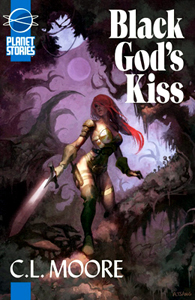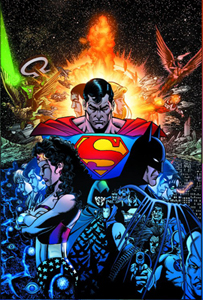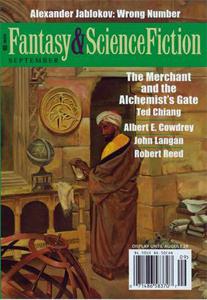Blech
Still feeling cruddy. It’s been so long since I was sick I forgot how annoying it is. Got some good editing done… but I think I’m going to crawl off to bed now.
Howard
Still feeling cruddy. It’s been so long since I was sick I forgot how annoying it is. Got some good editing done… but I think I’m going to crawl off to bed now.
Howard
I should have a post on the World Fantasy Convention up fairly soon. I came back with a low-grade fever and a couple of deadlines, and I have to deal with them first. In sum, John and I had a good time and met a lot of great people. More details in the next day or so.
Howard

Since 1999 Jenn Reese has made a name for herself writing fantasy tales at times whimsical, contemplative, and moving for markets as diverse as Strange Horizons, Flypaper, and Marion Zimmer Bradley’s Sword and Sorceress book anthologies. Now we finally have a novel from her, one with plenty of romance and exotic, kung-fu crime fighting to keep you reading. Black Gate’s Rich Horton gives you the details.
I’ve got a number of topics I’d love to post on, but they all require a bonafide essay, and I’ve been too slammed with editing and class prep work to devote any time to them. I’m stealing time right now for this short post, as a matter of fact.
World Fantasy Convention time is fast approaching. John O’Neill and I will be there manning the Black Gate booth, attending various panels, and mingling with the writers, editors, publishers, and artists, although the convention organizers insisted we leave the undead minions behind this time after that incident in the cafeteria last year.ÂÂ
If you’re planning to attend, we hope you’ll drop by and visit our booth.
The convention is being held in Saratoga Springs New York from November 1-November 4. More details can be found by following this link.
I’m apt to be away from the blog for another week or so, but more regular updates will return soon.
Warm Regards,
Howard

A few weeks ago we presented an interview with the head of Paizo Publishing. Now Black Gate‘s Ryan Harvey reviews the newest release in their Planet Stories line of pulp reprints. It’s a volume of tales featuring C. L. Moore’s S&S heroine extraordinaire Jirel of Joiry, and it’s one of the most complete Jirel collections ever assembled — read on to find out why.
 This week Black Gate turns its attention to the comics medium, as reviewer D. K. Latta investigates the latest earth-shattering miniseries to be presented in novel form by DC Comics. Is this outburst of existential mayhem (written by Greg Cox) truly something new, or does it follow in the timeworn footsteps of Crisis on Infinite Earths and its prodigious progeny of universe-altering storylines? D. K. has the answers inside.
This week Black Gate turns its attention to the comics medium, as reviewer D. K. Latta investigates the latest earth-shattering miniseries to be presented in novel form by DC Comics. Is this outburst of existential mayhem (written by Greg Cox) truly something new, or does it follow in the timeworn footsteps of Crisis on Infinite Earths and its prodigious progeny of universe-altering storylines? D. K. has the answers inside.
I don’t actually have the contracts in front of me yet, but it looks like the next three Harold Lamb books are a go through the University of Nebraska Press. I could tell you how happy I am about this, but you probably wouldn’t believe me unless you could see the immense, idiotic grin that’s been on my face for most of the last week when I heard about it, even through my neck injury.
Regular blog readers may or may not know that I assembled a series of four books reprinting all of Lamb’s swashbuckling Cossack stories for the University of Nebraska Press. They’re grand fiction, or I wouldn’t have spent years working to get them back into print. Here’s what the back cover says about Volume 1, Wolf of the Steppes:
“One of the finest adventure fiction writers of the twentieth century.†— Robert Weinberg
“Lamb knew how to write straight-ahead adventure the way Michelangelo knew how to paint.†— S. M. Stirling
“They are tales of wild adventure, full of swordplay, plots, treachery, startling surprises, mayhem, and massacre, laid in the most exotic setting that one can imagine and still stay in a known historical period on this planet.†— L. Sprague de Camp
Master of driving pace, exotic setting, and complex plotting, Harold Lamb was one of Robert E. Howard’s favorite writers. Here at last is every pulse-pounding, action-packed story of Lamb’s greatest hero, the wolf of the steppes, Khlit the Cossack. Journey now with the unsung grandfather of sword and sorcery in search of ancient tombs, gleaming treasure, and thrilling landscapes. Match wits with deadly swordsmen, scheming priests, and evil cults. Rescue lovely damsels, ride with bold comrades, and hazard everything on your brains and skill and a little luck.
Wolf of the Steppes is the first of a four-volume set that collects, for the first time, the complete Cossack stories of Harold Lamb and presents them in order: every adventure of Khlit the Cossack and those of his friends, allies, and fellow Cossacks, many of which have never before appeared between book covers. Compiled and edited by the Harold Lamb scholar Howard Andrew Jones, each volume features never-before reprinted essays Lamb wrote about his stories, informative introductions by popular authors, and a wealth of rare, exciting, swashbuckling fiction.
In this first volume, Khlit infiltrates a hidden fortress of assassins, tracks down the tomb of Genghis Khan, flees the vengeance of a dead emperor, leads the Mongol horde against impossible odds, accompanies the stunning Mogul queen safely through the land of her enemies, and much more. This is the stuff of grand adventure, from the pen of an American Dumas.
Lamb was a master plotter, and was way ahead of his time (the first of these were composed in 1917) as to his portrayal of non-Western cultures and women.ÂÂ
But… back to my main point, it looks like the second series of Lamb books I’ve proposed will indeed be seeing the light through the Bison Books imprint of the University of Nebraska Press. They will collect most of the rest of Lamb’s best historical fiction, tales written when Lamb’s prose was polished to a high gloss IN ADDITION to being chock full of the plot twists, exotic settings, and grand action scenes from his earlier work. Specifically they will be:
Swords From the West: A volume of Lamb’s Crusader stories, meaning mostly tales of Crusaders journeying not to the walls of Acre, but deep into Moslem and Mongol lands.
Swords From the East: A volume of adventure tales narrated by Moslem and Mongolian heroes.
Swords From the Sea: A volume of seafaring adventures, including bloody Viking stories, adventures of John Paul Jones amongst the Russian Navy, a short novel of the search for the North EAST passage, and other goodies.
I can hardly wait to see them on my bookshelves.
Here’s links to Harold Lamb’s four Cossack volumes, although I’m sure I’ve mentioned them before:
John’s advancing through the submissions I’ve forwarded to him, alternating between those tales and others that have drifted in through the mail. He’s completely focused now upon getting through those submissions so we can finally put long wait times behind us. When we re-open to subs, things should be much better.
Howard

Flesh eating mutants, golden apples, post-apocalyptic witches, and a crazy little thing called Love — just another day in the office for Black Gate reviewer David Soyka. This week he reviews notable offerings from Fantasy and Science Fiction and Interzone, issues featuring the work of authors such as Ted Chiang, John Lanagan, M. John Harrison, and Gwyneth Jones. Which one prompted David to exclaim, “Cormac McCarthy, eat your heart out!”? Click the link and find out.
There’s one fantasy show on television today that I don’t really hear people talking about. I mean fantasy in a stricter sense, not in the broad sense that would include science fiction or urban fantasy or horror; I mean epic fantasy in an imaginary land with simpler technology where magic works.
The show has vibrant and compelling characters, a richly textured world and mythology, and crisp, clever writing. To these eyes it is the best fantasy show yet produced for television; certainly it is hands down the best written animated show on TV today
I am referring, of course, to Avatar
Produced for Nickelodeon, at first blush Avatar may look like any other dozen Yu-gi-oh’s or Digios or Cheerimon’s or, indeed, any show with YA protagonists battling monsters. If all you’ve ever done is flip past, you’re unlikely to have seen anything striking.
If you stay long enough for one episode, you’re liable to be favorably impressed with the writing. If you stay for two or three half-hour shows, you start to appreciate the character development and if you watch for any longer… well, you might just get hooked.
Sure, sometimes the comedic elements are played a little too broadly for my taste, a la animé, but when that happens I remind myself that I’m not the intended audience. Avatar is an amazing storytelling cocktail, one that hasn’t produced any real clunkers in the approximately 40 half-hour episodes aired so far. It doesn’t talk down to its audience, and it doesn’t dumb down its writing. Fond as I am of Johnny Quest and a few other shows, there was nothing this good on television when I was a child. Heck, there’s rarely been any cartoon series on this good, ever, with the exception of the DC animated work from Bruce Timm and co. of the 90s and perhaps a handful of other recent shows. None of them, though, have handled such a long story arc so surely, so deftly. Almost every episode can stand on its own and can be viewed individually, yet when viewed in order each season forms a grand arc. Avatar is sure-footed storytelling.
For those of you not in the know, Avatar is set on an Asian-influenced fantasy world where there are four kingdoms named after the four elements: Earth, Air, Fire, and Water. Magic workers in each of the kingdoms can “bend,†or magically manipulate, the element native to their kingdom, with stylistic martial arts movements. The Avatar, reincarnated every generation, is the only man or woman who can manipulate all four elements. The titular Avatar, Aang, is a 12-year-old who was accidentally suspended for 100 years. While he lay dormant, the fire nation launched a war against the rest of the world. By the time Aang is revived by two teenagers from the water tribe, the fire nation has exterminated all of the air benders (save for Aang) and has nearly conquered the vast holdings of the Earth nation. Aang has the potential to master all of the elements, but he must learn them, and he must learn them quickly, if he is to stop the final push of the fire lord.
I suppose any synopsis could be rendered dull in summary, and perhaps I have managed it above. Or perhaps it’s not Avatar’s backstory so much as its delivery that makes it so excellent. The flawed, likable, lovable characters and their story arcs draw you into the epic. The painter has touched THIS canvas with large broad strokes and small subtle ones with equal mastery. Upon third and fourth viewing new surprises pop out of the backdrops and understanding deepens. I can’t imagine noticing much new from Scooby-Doo reruns.
The martial arts used in the show are fabulous – the magical and martial battles are simply amazing. In addition to everything else, Avatar is probably setting new high standards for animation. The climactic battles in key moments — for instance, the fire nation invasion of the water tribe stronghold at the end of the first season — must be seen to be believed. They’re as gorgeous as the grand battles in any high budget Hollywood blockbusters. I could go on and on, but I have been trying to keep my posts shorter these days, so I’ll shut up now, except that I will mention the first two seasons are available through Amazon right now.ÂÂ
It’s excellent stuff. Don’t miss it. Sooner or later people will be writing dissertations about this show. I find it hard to believe more adults aren’t talking about it
Howard